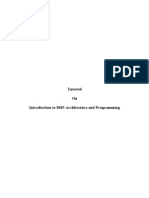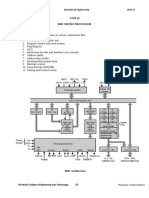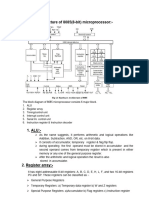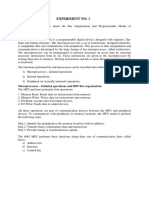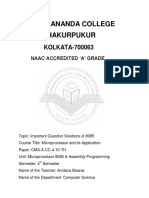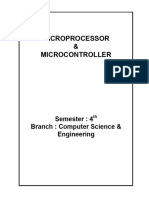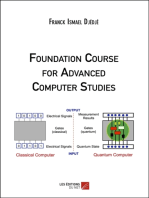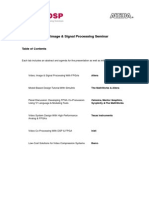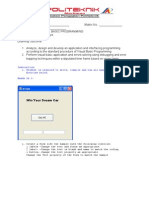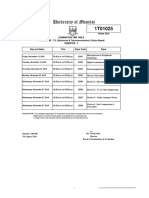Mpi Assignment Solution1
Mpi Assignment Solution1
Uploaded by
alkesh.engCopyright:
Available Formats
Mpi Assignment Solution1
Mpi Assignment Solution1
Uploaded by
alkesh.engOriginal Description:
Copyright
Available Formats
Share this document
Did you find this document useful?
Is this content inappropriate?
Copyright:
Available Formats
Mpi Assignment Solution1
Mpi Assignment Solution1
Uploaded by
alkesh.engCopyright:
Available Formats
Asst. Prof.
Alkesh M Khatri
MPI Sem- IV
Samarth College of Engineering and Technology
Unit 1 Introduction to 8 bit Microprocessor
Q.1.
Draw Schematic to Generate read / write Control Signal for memory and I/O of
8085 Microprocessor.
Q.2.
Draw & Explain Programming Model of 8085 Microprocessor. Explain
working of 16bit Register.
Q.3.
Explain Architecture of 8085 Microprocessor with help of Block diagram.
Explain Function of Each block in details.
Q.4.
Explain T State, Machine Cycle & Instruction Cycle.
Q.5.
Sketch the bus Structure of Microprocessor & Explain Data , Address and
Control Bus.
Q.6.
Draw Pin Diagram of 8085 Microprocessor and explain its pin configuration.
Asst. Prof. Alkesh M Khatri
MPI Sem- IV
Solution of Assignment 1
Q.1.
Draw Schematic to Generate read / write Control Signal for memory and I/O of
8085 Microprocessor.
Ans.1 Generating Control signals: The Mp provides RD and WR signals to initiate read
and write
cycle. Because these signals are used both for reading / writing
memory or reading writing an input/output device, it is necessary to generate
separate read and write signals for
memory
and
I/O
provides IO/M signal to indicate that initiated cycle is for
devices.
I/O
8085
device
or
for memory device. Using IO/M signal along with RD and WR, it is possible to
generate four signals shown below.
MEMR (Memory Read)
: To read data from memory
MEMW(Memory Write)
: To write data in memory
IOR (I/O Read)
: To read data from I/O devices
IOW (I/o Write)
: To write data in I/O devices.
We know that for OR gate , When the both inputs are low then only output is
low. The signal
IO/M signal goes low for memory operation. This signal is
logically OR-ed with RD and WR to
get MEMR and MEMW signals. When
both RD and IO/M signals go low, MEMR signals in
goes low. Similarly when
both WR and ME/MW signal goes low. To generate IO/R and IO/W
signals for I/O operation, IO/M signal is first inverted and then Logically OR-ed
with RD and WR signals.
Asst. Prof. Alkesh M Khatri
MPI Sem- IV
Same truth table can be implemented using 3:8 decoder.
Q.2.
Draw & Explain Programming Model of 8085 Microprocessor. Explain working
of 16bit Register.
Ans.1 The 8085 programming model includes six registers, one accumulator, and one
flag register, as shown in Figure. In addition, it has two 16-bit registers: the
stack pointer and the program
follows.
counter.
They
are
described
briefly
as
Asst. Prof. Alkesh M Khatri
MPI Sem- IV
Registers
The 8085 has six general-purpose registers to store 8-bit data; these are
identified as B,C,D,E,H, and L as shown in the figure. They can be combined as
register pairs -BC, DE, and HL - to perform some 16-bit operations. The
programmer can use these registers to store or copy data into the registers by
using data copy instructions.
Accumulator
The accumulator is an 8-bit register that is a part of arithmetic/logic unit (ALU).
This register is used to store 8-bit data and to perform arithmetic and logical
operations. The result of an operation is stored in the accumulator. The
accumulator is also identified as register A.
Flags
The ALU includes five flip-flops, which are set or reset after an operation
according to data conditions of the result in the accumulator and other registers.
They are called Zero(Z), Carry (CY), Sign (S), Parity (P), and Auxiliary Carry
(AC) flags; their bit positions in the flag register are shown in the Figure below.
The most commonly used flags are Zero, Carry, and Sign. The microprocessor
uses these flags to test data conditions.
For example, after an addition of two numbers, if the sum in the accumulator id
larger than eight bits, the flip-flop uses to indicate a carry -- called the Carry
flag (CY) -- is set to one. When an arithmetic operation results in zero, the flipflop called the
Zero(Z) flag is set to one. The first Figure shows an 8-bit
register, called the flag register, adjacent to the accumulator. However, it is not
used as a register; five bit positions out of eight are used to store the outputs of
the five flip-flops. The flags are stored in the 8-bit register so that the
programmer can examine these flags (data conditions) by accessing the register
through an instruction.
These flags have critical importance in the decision-making process of the
microprocessor.
Asst. Prof. Alkesh M Khatri
MPI Sem- IV
The conditions (set or reset) of the flags are tested through the software
instructions. For example, the instruction JC (Jump on Carry) is implemented to
change the sequence of a program when CY flag is set. The thorough
understanding of flag is essential in writing assembly language programs.
Program Counter (PC)
This 16-bit register deals with sequencing the execution of instructions. This
register is a memory pointer. Memory locations have 16-bit addresses, and that
is why this is a 16-bit register.
The microprocessor uses this register to sequence the execution of the
instructions. The function of the program counter is to point to the memory
address from which the next byte is to be fetched. When a byte (machine code)
is being fetched, the program counter is incremented by one to point to the next
memory location
Stack Pointer (SP)
The stack pointer is also a 16-bit register used as a memory pointer. It points to
a memory location in R/W memory, called the stack. The beginning of the stack
is defined by loading 16-bit address in the stack pointer.
This programming model will be used in subsequent tutorials to examine how
these registers are affected after the execution of an instruction.
Q.3.
Explain Architecture of 8085 Microprocessor with help of Block diagram.
Explain Function of Each block in details.
The functional block diagram or architecture of 8085 Microprocessor is very
important as it gives the complete details about a Microprocessor. Fig. shows
the Block diagram of a Microprocessor.
8085 Bus Structure:
Address Bus: The address bus is a group of 16 lines generally identified as A0
to A15.
The address bus is unidirectional: bits flow in one direction-from the MPU to
peripheral devices. The MPU uses the address bus to perform the first function:
identifying a peripheral or a memory location.
Asst. Prof. Alkesh M Khatri
MPI Sem- IV
Data Bus: The data bus is a group of eight lines used for data flow. These lines
are bi-directional data flow in both directions between the MPU and memory and
peripheral devices. The MPU uses the data bus to perform the second function:
transferring binary information. The eight data lines enable the MPU to
manipulate 8-bit data ranging from 00 to FF (28 = 256 numbers).The largest
number that can appear on the data bus is 11111111.
Control Bus: The control bus carries synchronization signals and providing timing
signals. The MPU generates specific control signals for every operation it
performs. These signals are used to identify a device type with which the MPU
wants to communicate.
Registers of 8085:
The 8085 have six general-purpose registers to store 8-bit data during program
execution. These registers are identified as B, C, D, E, H, and L.They can be
combined as register pairs-BC, DE, and HL-to perform some 16-bit operations.
Accumulator (A):
The accumulator is an 8-bit register that is part of the arithmetic/logic unit
(ALU).
This register is used to store 8-bit data and to perform arithmetic and logical
operations.
The result of an operation is stored in the accumulator.
Flags:
Asst. Prof. Alkesh M Khatri
MPI Sem- IV
The ALU includes five flip-flops that are set or reset according to the result of
an operation.
The microprocessor uses the flags for testing the data conditions.
They are Zero (Z), Carry (CY), Sign (S), Parity (P), and Auxiliary Carry
(AC) flags. The most commonly used flags are Sign, Zero, and Carry.
The bit position for the flags in flag register is,
1. Sign Flag (S): After execution of any arithmetic and logical operation, if
D7 of the result is 1, the sign flag is set. Otherwise it is reset.D7 is
reserved for indicating the sign; the remaining is the magnitude of
number. If D7 is 1, the number will be viewed as negative number. If D7
is 0, the number will be viewed as positive number.
2. Zero Flag (z): If the result of arithmetic and logical operation is zero,
then zero flag is set otherwise it is reset.
3. Auxiliary Carry Flag (AC): f D3 generates any carry when doing any
arithmetic and logical operation, this flag is set. Otherwise it is reset.
4.
Parity Flag (P): If the result of arithmetic and logical operation contains
even number of 1's then this flag will be set and if it is odd number of 1's
it will be reset.
5.
Carry Flag (CY):If any arithmetic and logical operation result any carry
then carry flag is set otherwise it is reset.
Arithmetic and Logic Unit (ALU):It is used to perform the arithmetic operations like
addition, subtraction, multiplication, division, increment and decrement and logical
operations like AND, OR and EX-OR. It receives the data from accumulator and
registers. According to the result it set or reset the flags.
Program Counter (PC): This 16-bit register sequencing the execution of instructions. It
is a memory pointer. Memory locations have 16-bit addresses, and that is why
this is a 16-bit register. The function of the program counter is to point to the
memory address of the next instruction to be executed. When an opcode is
being fetched, the program counter is incremented by one to point to the next
memory location.
Stack Pointer (Sp): The stack pointer is also a 16-bit register used as a memory
pointer. It points to a memory location in R/W memory, called the stack. The
Asst. Prof. Alkesh M Khatri
MPI Sem- IV
beginning of the stack is defined by loading a 16-bit address in the stack pointer
(register).
Temporary Register: It is used to hold the data during the arithmetic and logical
operations.
Instruction Register: When an instruction is fetched from the memory, it is
loaded in the instruction register.
Instruction Decoder: It gets the instruction from the instruction register and
decodes the instruction. It identifies the instruction to be performed.
Serial I/O Control: It has two control signals named SID and SOD for serial
data transmission.
Timing and Control unit.
It has three control signals ALE, RD (Active low) and WR (Active low) and
three status signals IO/M(Active low), S0 and S1.
ALE is used for provide control signal to synchronize the components of
microprocessor and timing for instruction to perform the operation.
RD (Active low) and WR (Active low) are used to indicate whether the
operation is reading the data from memory or writing the data into memory
respectively.
IO/M(Active low) is used to indicate whether the operation is belongs to the
memory or peripherals.
Table 1.3 Machine cycle status and control signals
Q.4.
Explain T State, Machine Cycle & Instruction Cycle.
T State:
T-state is defined as one subdivision of the operation performed in one clock period
Asst. Prof. Alkesh M Khatri
MPI Sem- IV
The execution of instruction always requires read and writes operations to transfer data
to or from the P and memory or I/O devices. Each read/ write operation constitutes
one machine cycle (MC1). Each machine cycle consists of many clock periods/ cycles,
called T-states.
Machine Cycle:
Machine cycle is defined as the time required completing one operation of accessing
memory, I/O or acknowledging an external request.
Usually machine cycle consists of 3 to 6 T-states. In this article let us discuss about
their
different types and how they are being classified.
Types of machine cycle
There are various types of machine cycles which are classified based onStatus signals
(IO/M, S1 and S0) ,Control Signals (RD, WR, INTA).
The different types of machine cycle available in 8085 microprocessor are:
Opcode Fetch
Memory Read
Memory write
I/O Read
I/O Write
INTR Acknowledge
Bus Idle
Asst. Prof. Alkesh M Khatri
MPI Sem- IV
Instruction cycle:
Instruction cycle is defined, as the time required completing the execution of an
instruction.
The time taken by the P in performing the fetch and execute operations are called
fetch and execute cycle. Thus, sum of the fetch and execute cycle is called the
instruction cycle as indicated in Fig.
Q.5.
Sketch the bus Structure of Microprocessor & Explain Data , Address and
Control Bus.
Typical system uses a number of busses, collection of wires, which transmit binary
numbers, one bit per wire. A typical microprocessor communicates with memory and
other devices (input and output) using three busses: Address Bus, Data Bus and
Control Bus.
Address Bus
One wire for each bit, therefore 16 bits = 16 wires. Binary number carried alerts
memory to open the designated box. Data (binary) can then be put in or taken
out.The Address Bus consists of 16 wires, therefore 16 bits. Its "width" is 16 bits. A 16
bit binary number allows 216 different numbers, or 32000 different numbers, ie
0000000000000000 up to 1111111111111111. Because memory consists of boxes, each
with a unique address, the size of the address bus determines the size of memory,
Asst. Prof. Alkesh M Khatri
MPI Sem- IV
which can be used. To communicate with memory the microprocessor sends an address
on the address bus, eg 0000000000000011 (3 in decimal), to the memory. The
memory the selects box number 3 for reading or writing data.
Address bus is unidirectional, ie numbers only sent from microprocessor to memory, not
other way.
Data Bus
Data Bus: carries data, in binary form, between P and other external units, such as
memory. Typical size is 8 or 16 bits. Size determined by size of boxes in memory and
P size helps determine performance of P. The Data Bus typically consists of 8 wires.
Therefore, 28 combinations of binary digits. Data bus used to transmit "data", ie
information, results of arithmetic, etc, between memory and the microprocessor.
Bus is bi-directional. Size of the data bus determines what arithmetic can be done. If
only 8 bits wide then largest number is 11111111 (255 in decimal). Therefore, larger
number have to be broken down into chunks of 255. This slows microprocessor. Data
Bus also carries instructions from memory to the microprocessor. Size of the bus
therefore limits the number of possible instructions to 256, each specified by a separate
number.
Control Bus
Control Bus are various lines which have specific functions for coordinating and
controlling uP operations. Eg: Read/NotWrite line, single binary digit. Control whether
memory is being written to (data stored in mem) or read from (data taken out of
mem) 1 = Read, 0 = Write. May also include clock line(s) for timing/synchronising,
interrupts, reset etc. Typically P has 10 control lines. Cannot function correctly
without these vital control signals.
The Control Bus carries control signals partly unidirectional, partly bi-directional. Control
signals are things like "read or write". This tells memory that we are either reading
from a location, specified on the address bus, or writing to a location specified. Various
other signals to control and coordinate the operation of the system.
Q.6.
Draw Pin Diagram of 8085 Microprocessor and explain its pin configuration.
The following describes the function of each pin:
Pin Diagram and Pin description of 8085
8085 is a 40 pin IC, The signals from the pins can be grouped as follows
Asst. Prof. Alkesh M Khatri
MPI Sem- IV
1. Power supply and clock signals
2. Address bus
3. Data bus
4. Control and status signals
5. Interrupts and externally initiated signals
6. Serial I/O ports
1. Power supply and Clock frequency signals:
Vcc:
+ 5 volt power supply
Vss:
Ground
X1, X2 :
Crystal or R/C network or LC network connections to set the frequency of internal
clock generator. The frequency is internally divided by two. Since the basic operating
timing frequency is 3 MHz, a 6 MHz crystal is connected externally. CLK (output)-Clock
Output is used as the system clock for peripheral and devices interfaced with the
microprocessor.
2. Address Bus:
Asst. Prof. Alkesh M Khatri
MPI Sem- IV
A8 - A15:
(output; 3-state) It carries the most significant 8 bits of the memory address or the 8
bits of the I/O address;
3. Data bus:
AD0 - AD7 (input/output; 3-state):
These multiplexed set of lines used to carry the lower order 8 bit address as well as
data bus.
During the opcode fetch operation, in the first clock cycle, the lines deliver the lower
order address A0 - A7.
In the subsequent IO / memory, read / write clock cycle the lines are used as data
bus.
The CPU may read or write out data through these lines.
4. Control and Status signals:
ALE (output) - Address Latch Enable.
It is an output signal used to give information of AD0-AD7 contents.
It is a positive going pulse generated when a new operation is started by uP.
When pulse goes high it indicates that AD0-AD7 are address.
When it is low it indicates that the contents are data.
RD (output 3-state, active low) - Read memory or IO device.
This indicates that the selected memory location or I/O device is to be read and that
the data bus is ready for accepting data from the memory or I/O device
WR (output 3-state, active low) - Write memory or IO device.
This indicates that the data on the data bus is to be written into the selected memory
location or I/O device.
IO/M (output) - Select memory or an IO device.
This status signal indicates that the read / write operation relates to whether the
memory or I/O device.
It goes high to indicate an I/O operation.
It goes low for memory operations.
5. Status Signals:
S1:
S2:
It is used to know the type of current operation of the microprocessor.
Asst. Prof. Alkesh M Khatri
MPI Sem- IV
IO/M
S1
S0
OPERATION
Opcode fetch
Memory read
Memory write
I/O read
I/O write
Interrupt acknowledge
Halt
Hold
Reset
6. Interrupts and Externally initiated operations:
They are the signals initiated by an external device to request the microprocessor to do
a particular task or work.
There are five hardware interrupts called,
1.TRAP
2.RST 7.5
3.RST 6.5
4.RST 5.5
5.INTA
On receipt of an interrupt, the microprocessor acknowledges the interrupt by the active
low INTA (Interrupt Acknowledge) signal.
Reset In (input, active low)
This signal is used to reset the microprocessor.
The program counter inside the microprocessor is set to zero.
The buses are tri-stated.
Reset Out (Output)
It indicates CPU is being reset.
Used to reset all the connected devices when the microprocessor is reset.
7. Direct Memory Access (DMA): Tri state devices:
When 2 or more devices are connected to a common bus, to prevent the devices from
interfering with each other, the tristate gates are used to disconnect all devices except
the one that is communicating at a given instant.
Asst. Prof. Alkesh M Khatri
MPI Sem- IV
The CPU controls the data transfer operation between memory and I/O device. Direct
Memory Access operation is used for large volume data transfer between memory and
an I/O device directly.
The CPU is disabled by tri-stating its buses and the transfer is effected directly by
external control circuits.
HOLD signal is generated by the DMA controller circuit. On receipt of this signal, the
microprocessor acknowledges the request by sending out HLDA signal and leaves out
the control of the buses. After the HLDA signal the DMA controller starts the direct
transfer of data.
READY (input)
Memory and I/O devices will have slower response compared to microprocessors.
Before completing the present job such a slow peripheral may not be able to handle
further data or control signal from CPU.
The processor sets the READY signal after completing the present job to access the
data.
The microprocessor enters into WAIT state while the READY pin is disabled.
8. Single Bit Serial I/O ports:
SID (input)
- Serial input data line
SOD (output)
These signals are used for serial communication.
- Serial output data line
You might also like
- Assembly Language:Simple, Short, And Straightforward Way Of Learning Assembly ProgrammingFrom EverandAssembly Language:Simple, Short, And Straightforward Way Of Learning Assembly ProgrammingRating: 2 out of 5 stars2/5 (1)
- GIS Based PT System PPT-FinalDocument72 pagesGIS Based PT System PPT-Finalsandhya lagusani100% (3)
- 8085 MicroprocessorDocument23 pages8085 Microprocessorauromaaroot196% (55)
- MCQ For DSPDocument39 pagesMCQ For DSPalkesh.eng78% (9)
- Case-Based Reinforcement Learning For Dynamic Inventory Control in A Multi-Agent Supply-Chain SystemDocument7 pagesCase-Based Reinforcement Learning For Dynamic Inventory Control in A Multi-Agent Supply-Chain SystemUmang SoniNo ratings yet
- Rohini 69771659590Document7 pagesRohini 69771659590simman8371029No ratings yet
- L-3 8 Bits MicroprocessorDocument12 pagesL-3 8 Bits Microprocessormuhamed.abdelhamid16No ratings yet
- MPI GTU Study Material E-Notes Unit-3 13052022115048AMDocument15 pagesMPI GTU Study Material E-Notes Unit-3 13052022115048AMmailsender787No ratings yet
- Microprocessor 8085 Architecture: 3.2 Block Diagram of 8085Document16 pagesMicroprocessor 8085 Architecture: 3.2 Block Diagram of 8085Kannan Muthusamy100% (1)
- MCT Unit 2Document26 pagesMCT Unit 2Aravind RajNo ratings yet
- Architecture Diagram of 8085 MicroprocessorDocument4 pagesArchitecture Diagram of 8085 MicroprocessorbhatiaharryjassiNo ratings yet
- Question: Describe The 8085 Programming Model in Detail. Answer: Following Is The Answer To The Above QuestionDocument9 pagesQuestion: Describe The 8085 Programming Model in Detail. Answer: Following Is The Answer To The Above QuestionSidh SinghNo ratings yet
- MICROPORCESSOR 8085 Lab ManualDocument53 pagesMICROPORCESSOR 8085 Lab ManualAjay PatilNo ratings yet
- Computer Organization Architecture and Assembly Language File/8085 FileDocument32 pagesComputer Organization Architecture and Assembly Language File/8085 FileGarimaNo ratings yet
- MP & MC Micro Doc-20240520-Wa0000Document82 pagesMP & MC Micro Doc-20240520-Wa0000Deba Comedy ClubNo ratings yet
- Sec 1323Document118 pagesSec 1323vkyashraj20No ratings yet
- MicroprocessorsDocument11 pagesMicroprocessors158 AshleshaNo ratings yet
- COA - Summer-2024 SolutionDocument26 pagesCOA - Summer-2024 Solutionzayoxop666No ratings yet
- Microprocessors and Microcontrollers NotesDocument293 pagesMicroprocessors and Microcontrollers NotesKumar ChaitanyaNo ratings yet
- Cs2252 - MPMC 16 M With Answers Upto 2Document40 pagesCs2252 - MPMC 16 M With Answers Upto 2archumeenabaluNo ratings yet
- Unit 2 ActivityDocument19 pagesUnit 2 ActivityRiza Pahama Mananaong100% (1)
- Experiment No: 1: OBJECTIVE: To Study About The Bus Organization and Programmable Model ofDocument5 pagesExperiment No: 1: OBJECTIVE: To Study About The Bus Organization and Programmable Model ofRutul PrajapatiNo ratings yet
- Exp - 1Document7 pagesExp - 1rk5336222No ratings yet
- Important Question Solutions of 8085 - ComputerSCDocument59 pagesImportant Question Solutions of 8085 - ComputerSCParamartha BanerjeeNo ratings yet
- MPMC Assignment-1Document7 pagesMPMC Assignment-113Panya CSE2No ratings yet
- Unit I Microprocessor NotesDocument15 pagesUnit I Microprocessor NotesSaritha ReddyNo ratings yet
- Ee6502 Microprocessors and MicrocontrollersDocument97 pagesEe6502 Microprocessors and MicrocontrollersAnbalagan Guru0% (1)
- EE6502 Microprocessors and MicrocontrollersDocument66 pagesEE6502 Microprocessors and Microcontrollerssonu sabooNo ratings yet
- Intel 8085 ArchitectureDocument8 pagesIntel 8085 ArchitectureAravind VJNo ratings yet
- 8085 MicroprocessorDocument13 pages8085 MicroprocessorSajid Akram100% (1)
- 8085 Important Short Questions (Part-1)Document11 pages8085 Important Short Questions (Part-1)Ln Amitav BiswasNo ratings yet
- 1 8085 Microprocessor ArchitectureDocument7 pages1 8085 Microprocessor Architecturejosrichman75No ratings yet
- Microprocessor Lecture 1Document4 pagesMicroprocessor Lecture 1rspahlobNo ratings yet
- 8085 ArchitectureDocument17 pages8085 ArchitectureSamaira Shahnoor ParvinNo ratings yet
- MPMC - Unit 1 - 8085 ArchitectureDocument17 pagesMPMC - Unit 1 - 8085 ArchitectureWickNo ratings yet
- Basics of Micro ProcessorDocument27 pagesBasics of Micro ProcessorBibin LeeNo ratings yet
- Tutorial On Introduction To 8085 Architecture and ProgrammingDocument23 pagesTutorial On Introduction To 8085 Architecture and ProgrammingKorak MitraNo ratings yet
- MP UNIT 1&2 - ClassDocument63 pagesMP UNIT 1&2 - Classaarav.a211123No ratings yet
- W3 Microprocessor Architecture Module 3Document15 pagesW3 Microprocessor Architecture Module 3Aaron BasNo ratings yet
- CO NotesDocument116 pagesCO NotesEmaad Ali KhanNo ratings yet
- FMM Unit-1Document28 pagesFMM Unit-1CS ENo ratings yet
- Microprocessor 8085Document25 pagesMicroprocessor 8085hetal_limbaniNo ratings yet
- Microprocessor - SGDocument15 pagesMicroprocessor - SGSugata Ghosh0% (1)
- Unit I The 8086 MicroprocessorDocument21 pagesUnit I The 8086 Microprocessor16211a0470100% (1)
- ANS Computer Awareness Year 1Document4 pagesANS Computer Awareness Year 1virad25No ratings yet
- 8085 MicroprocessorDocument10 pages8085 MicroprocessorgravitoniteNo ratings yet
- Microprocessor 8085 ArchitectureDocument19 pagesMicroprocessor 8085 ArchitectureSindhujaSindhuNo ratings yet
- Ebooks For FreeDocument24 pagesEbooks For FreeNihar KhuranaNo ratings yet
- Wa0000.Document91 pagesWa0000.Deba Comedy ClubNo ratings yet
- Micro Processor DineshDocument9 pagesMicro Processor DineshsandyNo ratings yet
- Preliminary Specifications: Programmed Data Processor Model Three (PDP-3) October, 1960From EverandPreliminary Specifications: Programmed Data Processor Model Three (PDP-3) October, 1960No ratings yet
- The Elements of Computing Systems, second edition: Building a Modern Computer from First PrinciplesFrom EverandThe Elements of Computing Systems, second edition: Building a Modern Computer from First PrinciplesNo ratings yet
- Practical Reverse Engineering: x86, x64, ARM, Windows Kernel, Reversing Tools, and ObfuscationFrom EverandPractical Reverse Engineering: x86, x64, ARM, Windows Kernel, Reversing Tools, and ObfuscationNo ratings yet
- Introduction to Computer Organization: An Under the Hood Look at Hardware and x86-64 AssemblyFrom EverandIntroduction to Computer Organization: An Under the Hood Look at Hardware and x86-64 AssemblyNo ratings yet
- PLC: Programmable Logic Controller – Arktika.: EXPERIMENTAL PRODUCT BASED ON CPLD.From EverandPLC: Programmable Logic Controller – Arktika.: EXPERIMENTAL PRODUCT BASED ON CPLD.No ratings yet
- C Programming for the Pc the Mac and the Arduino Microcontroller SystemFrom EverandC Programming for the Pc the Mac and the Arduino Microcontroller SystemNo ratings yet
- CISPR 24 - Ed.2.0 - 2010 - EQL - 2016-07-01Document2 pagesCISPR 24 - Ed.2.0 - 2010 - EQL - 2016-07-01alkesh.engNo ratings yet
- IEC60598 1 MarkingDocument6 pagesIEC60598 1 Markingalkesh.engNo ratings yet
- Iecx UpdatedDocument16 pagesIecx Updatedalkesh.engNo ratings yet
- Academic Calendar DegreeDocument1 pageAcademic Calendar Degreealkesh.engNo ratings yet
- Samarth Colleges of Engineering and Technology, HimmatnagarDocument1 pageSamarth Colleges of Engineering and Technology, Himmatnagaralkesh.engNo ratings yet
- (A) Wire Colour Identification (Iec 60204-1) : Prima Automation (I) Pvt. LTDDocument2 pages(A) Wire Colour Identification (Iec 60204-1) : Prima Automation (I) Pvt. LTDalkesh.engNo ratings yet
- MW QuestionsDocument6 pagesMW Questionsalkesh.engNo ratings yet
- Info Iec60364-4-41 (Ed5.0) en DDocument7 pagesInfo Iec60364-4-41 (Ed5.0) en Dalkesh.engNo ratings yet
- Gujarat Technological UniversityDocument2 pagesGujarat Technological Universityalkesh.engNo ratings yet
- MW QuestionsDocument6 pagesMW Questionsalkesh.engNo ratings yet
- Lecture 1423813824Document74 pagesLecture 1423813824alkesh.engNo ratings yet
- I Belive in Silence and You What To Hear My WordsDocument1 pageI Belive in Silence and You What To Hear My Wordsalkesh.engNo ratings yet
- Gujarat Technological UniversityDocument3 pagesGujarat Technological Universityalkesh.engNo ratings yet
- CommunicationDocument22 pagesCommunicationalkesh.engNo ratings yet
- Loop AntennaDocument12 pagesLoop Antennaalkesh.eng100% (2)
- Mpi 11002Document21 pagesMpi 11002alkesh.eng0% (1)
- Mpi Assignment Solution3Document25 pagesMpi Assignment Solution3alkesh.engNo ratings yet
- CommunicationDocument22 pagesCommunicationalkesh.engNo ratings yet
- Results 1Document1 pageResults 1alkesh.engNo ratings yet
- 3 Vol 15 No 1Document6 pages3 Vol 15 No 1alkesh.engNo ratings yet
- Operating System Notes 3 - TutorialsDuniya PDFDocument232 pagesOperating System Notes 3 - TutorialsDuniya PDFKhalid RehmanNo ratings yet
- KDocument2 pagesKMian AzanNo ratings yet
- Auto Cad CommandsDocument5 pagesAuto Cad CommandsgkalufabNo ratings yet
- Quocapital PDFDocument1 pageQuocapital PDFAlwin Abreu BarretoNo ratings yet
- KMP AlgorithmDocument3 pagesKMP Algorithmmuffi840No ratings yet
- UNIT-3: - Relations and Ordering - Lattices - Boolean AlzebraDocument61 pagesUNIT-3: - Relations and Ordering - Lattices - Boolean Alzebranaman jaiswalNo ratings yet
- Discrete Event SimulationDocument33 pagesDiscrete Event SimulationMuhammad AnsNo ratings yet
- Fall 2021 - CS401P - 3Document2 pagesFall 2021 - CS401P - 3ahali001111No ratings yet
- Fortios Handbook 56Document3,447 pagesFortios Handbook 56davidNo ratings yet
- Midterm 3Document3 pagesMidterm 3SamanthaNo ratings yet
- Code:DSP Video, Image & Signal Processing SeminarDocument7 pagesCode:DSP Video, Image & Signal Processing Seminarnahhh123No ratings yet
- Netxms User ManualDocument88 pagesNetxms User ManualNaga Raju N100% (1)
- LTE L1 Bit Calculator v1.05Document12 pagesLTE L1 Bit Calculator v1.05Anonymous oLo6cDDNo ratings yet
- Proofpoint Reference GuideDocument136 pagesProofpoint Reference Guidesenthil kumarNo ratings yet
- OoseDocument70 pagesOoseanrgrtNo ratings yet
- Programming Fundamentals A Modular Structured ApproachDocument444 pagesProgramming Fundamentals A Modular Structured ApproachoperationalprocesssuccessNo ratings yet
- BlackBerry Desktop Software Version 6.0.1 B21 Release NotesDocument6 pagesBlackBerry Desktop Software Version 6.0.1 B21 Release NotesBlackBerryRocks.comNo ratings yet
- Sir Naveed Lecture # 01Document3 pagesSir Naveed Lecture # 01Rehan AliNo ratings yet
- Class 5 CH 2 Answers 1Document6 pagesClass 5 CH 2 Answers 1Gurudas SutradharNo ratings yet
- Amali 3Document4 pagesAmali 3CIK JOYAHNo ratings yet
- ADXL345Document24 pagesADXL345Dzouato BonaventureNo ratings yet
- Stores Management and Materials HandlingDocument21 pagesStores Management and Materials HandlingMr. Umang PanchalNo ratings yet
- Q1. What Is The Purpose of The Programming? Ans - If We Want To Communicate A Computer Then We Should Go For Programming LanguageDocument40 pagesQ1. What Is The Purpose of The Programming? Ans - If We Want To Communicate A Computer Then We Should Go For Programming LanguageDhruva MishraNo ratings yet
- Sap S4 HanaDocument47 pagesSap S4 HanaAdaikalam Alexander Rayappa100% (7)
- University of Mumbai: Important NoteDocument1 pageUniversity of Mumbai: Important NoteHamza KhanNo ratings yet
- Worksheet 3 More About Scratch Final PDFDocument2 pagesWorksheet 3 More About Scratch Final PDFRaj MalkanNo ratings yet
- Netflix HistoryDocument4 pagesNetflix HistoryAlbert OtienoNo ratings yet
- Tutorial - Master - Detail PDFDocument8 pagesTutorial - Master - Detail PDFSinan YıldızNo ratings yet



